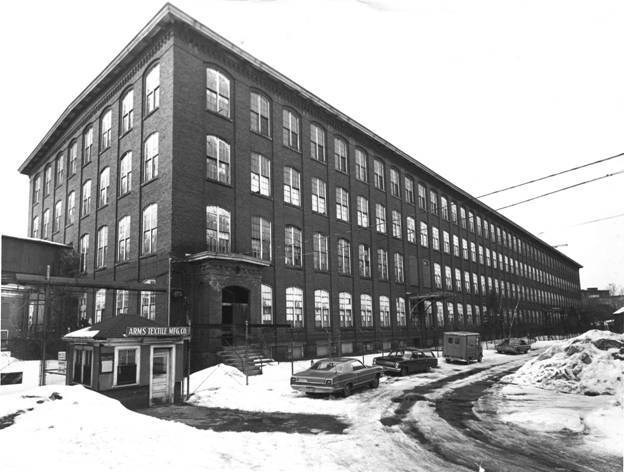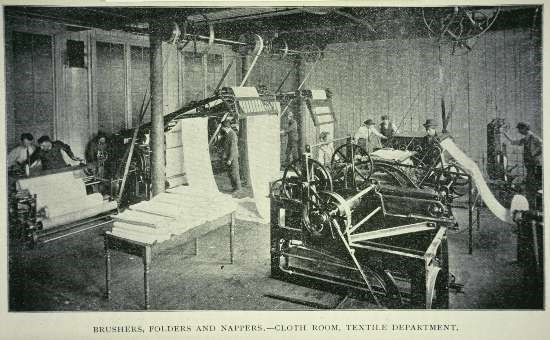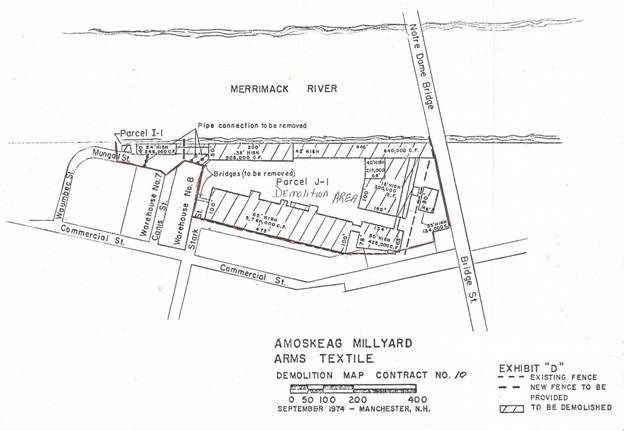You are standing on the site of the former Arms Textile Mill, a massive brick structure very similar to the remaining buildings in the Mill Yard; brought down by a simple twist of fate.

In 1957 the Mill was actively making fashionable men’s coats when it received a single shipment of dark goat hair from Pakistan, used to make the lining. Days later Antonio Jette came home from a routine shift in the Mill feeling exhausted. He thought he was coming down with a cold, but died several days later. For Albert Langlois, who was hired at the Mill two months earlier, it started as a dry scratchy throat. He was dead in three days. Over the next 10 weeks a total of 9 men and one woman, all working different jobs at different locations within the Mill, became severely ill. Five of them died.
In the ensuing investigation, public health officials determined the one exposure that all nine mill workers had in common: each had in some way come into contact with that single shipment of goat hair. As the shipment was processed into wool, Anthrax spores that were clinging to the goat hair were spread around the Mill.

Anthrax is an infection caused by a bacteria which produces powerful and deadly toxins. It is contracted from exposure to spores, an inactive form of the bacteria that can exist dormant for decades before reawakening in the body to grow and wreak havoc. While rare in Europe and North America, Anthrax is more common in Africa and Asia where grass eating animals are the main host. Infected animals die releasing spores which are then ingested by other grass eating animals.
A second twist of fate
Although this was America’s first and most deadly epidemic of Anthrax, it could have been a lot worse. Many more Mill workers were exposed to that contaminated shipment. In a second twist of fate, it just so happened that the CDC and US Army was testing a vaccine for Anthrax in the Arms Mill during 1957. None of the workers who died had been given the vaccine, but none of those vaccinated became ill. Once the cause of the illness became apparent, the trial was stopped, all the workers were given the vaccine, and no more illnesses occurred. For at least nine years…
A third twist of fate
In 1966 Norbert Lemoine, who worked at a machine shop across the alley, died from anthrax after inhaling spores that had drifted over from the Arms Mill.
The Mill’s Fate
The Mill went out of business and was shuttered. During the revitalization of Manchester’s Mill Yard in the 1970’s the Arms Mill was torn down brick by brick, its beams incinerated, its bricks soaked in chlorine and buried a half mile away. At the time it was the largest decontamination project in US history.

A fourth twist of fate
The place where the bricks were buried was filled-in to become Singer Park. In 2004 during construction of the Fisher Cats stadium on that site, utility workers hit the bricks sparking fears of another outbreak. Construction stopped and the CDC was called in. Although they advised against testing, the unions ran tests anyway. Three samples tested negative for Anthrax, but a fourth was positive. The risk was considered remote, construction resumed, and no construction worker contracted Anthrax.
Final twist of fate
When UNH first established a school of public health it was located in the mill at 400 Commercial St. overlooking Arms Park (in the space to the right of Cotton). They have since moved to the Pandora Mill just down the street.
Postscript:
In 2009 a 24 year old Manchester woman became critically ill after participating in a drumming circle at the University of New Hampshire. It turns out she had swallowed anthrax spores that were likely aerosolized from the African goat skin used to make of one of the drums. It was unrelated to Arms Mill.
To log:
Please submit your answers to the following questions
1. Arms Mill Park is a cooperative project from which three agencies? (Information sign)
2. What is the modern public health advisory posted on two adjacent lamp posts? (May be seasonal)
3. The mills were built here to take advantage of hydro-power. Coal was a competitive source of power. What is the connection between Anthrax and Coal? (Hint: you may have to look it up. Its in the name)
Sources:
https://www.nytimes.com/2001/10/27/us/nation-challenged-epidemic-anthrax-outbreak-57-felled-mill-but-yielded-answers.html
http://nhpr.org/post/anthrax-manchester-revisiting-arms-mill-outbreak-1957
https://www.nytimes.com/2009/12/30/us/30anthrax.html
Manchester Historic Association
Virtual Reward - 2017/2018
This Virtual Cache is part of a limited release of Virtuals created between August 24, 2017 and August 24, 2018. Only 4,000 cache owners were given the opportunity to hide a Virtual Cache. Learn more about Virtual Rewards on the Geocaching Blog.